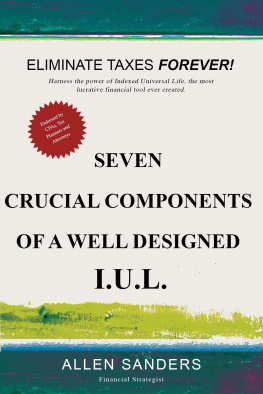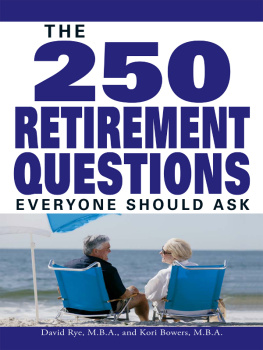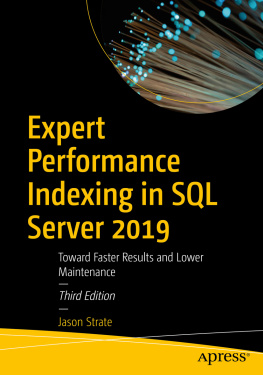CONTENTS
Seven Crucial Components
Of A Well Designed I.U.L.
By
Allen Sanders
Financial Strategist
Copyright 2016 by Allen Sanders
All rights reserved.
ASIN: B00SKJCG2I
Title: Seven Crucial Components Of A Well Designed I.U.L.
Original and modified cover art by Kasia and CoverDesignStudio.com.
CHAPTER ONE
A Few Stories
Before we launch into the details of designing an I.U.L. contract, I'm going to first share a few stories about clients I have personally helped to set up one or more I.U.L. contracts. These clients have widely varied reasons for utilizing these amazing programs, and youll probably identify with at least one of these scenarios. The design elements and technical know-how are important, but these contracts are not just financial technology items: they perform for people. Those end result goals are the main reasons for opening an I.U.L. contract.
Here are a few key examples of how my clients used an I.U.L. to meet their specific goals:
How Do I Create A Tax-Free Inheritance For My Heirs?
Since the 1970s Alice had worked hard to accumulate over $200,000 in a non-qualified annuity. The cost basis was only $35,000. Her three heirs were set to inherit the account and split it 3 ways, which would have required them to pay taxes on more than $55,000 each. As her annuity was originally set up, the dollar amounts were growing each year, and were exponentially increasing tax liabilities for her heirs. All the additional income would have been added to the gross income of each heir in each tax year. This would have created a massive tax burden for each heir on both the inherited money AND on the regular income they would have earned in any given tax year as well.
The solution? An I.U.L. contract for $225,000 was approved and at Alices age of 70 we began transferring $17,950 per year from the annuity into the I.U.L. This solved 2 problems it funded the I.U.L. with enough premiums that it would need no payments after year 15. If Alice dies before year 15, her heirs get all of the life insurance benefit tax-free AND they receive future payments remaining from the annuity. If she dies after year 15, they receive the life payments and whatever growth has occurred in the I.U.L. - tax free. The reason for using an I.U.L. instead of another type of life contract was to increase and protect potential growth in the account. It has worked exactly as planned, and Alice's three heirs will now inherit and split over $225,000 TAX FREE.
Can I Purchase Term Life Insurance Now And Convert To An I.U.L. Later?
Bryan and Shauna - a newly married couple contacted me for help designing two I.U.L.s - one for each of them. The issue was that Bryan was still attending graduate school and their combined cash flow was going to be low for another 6 months. They didnt want to wait until he graduated to start their I.U.L.s, so we designed a Term Life insurance contract to be paid as Annual Renewable Term. The premiums at their young ages were less than $10 per month for both husband and wife, and they were able to lock in their health qualifications for any period of time they wished. As their income grew, they were able to convert the Term policy to an I.U.L. that grew cash value linked to the S&P 500 Index. If either of them suddenly developed a serious illness before the conversion took place, it will not have affected their ability to begin the I.U.L. The two Indexed Universal Life contracts gave them the ability to save money for retirement, create college savings for their kids, and meet any future financial goal they desired.
What If I'm Self Employed And Phased Out Of Roth IRA Limits?
Another young couple wanted to save for retirement and was concerned about the effect of rising taxes in the future. Self-employed Joseph had landed a huge contract with Home Depot to write software for their point-of-sale system. He had cash flowed $250,000 for several years in a row and had saved a large percentage of that money. Consequently, he and his wife were phased out of contributing to a Roth IRA. He really liked the tax treatment of Roth IRAs and did not want to pay taxes in retirement. Once this couple learned about the possibility of tax-free retirement in an I.U.L., they quickly opened 2 contracts and sent $1,000 per month into each one. They planned on using part of one for college savings for their young child, and then use the other one for large purchases like homes, business startup capital, etc. Anything remaining in the accounts plus the monthly contributions would be saved until they retired. Our conservative projections show them with a potential $135,000 in retirement income, which will be completely tax free. That number could be slightly different based on market performance, but they will never have to worry about losses or taxes. A great story.
What If I Create An I.U.L. For Retirement And Die Unexpectedly?
A couple in their late 50s was interested in saving a large percentage of their excess income for retirement. They were highly concerned that all of their assets had been built up in pensions, social security, IRAs, and 403bs - ALL of which are taxable. When I showed them the tax-free possibilities of an I.U.L., they each began contributing $1,500 to their separate accounts. The death benefit for his was $250,000, and hers was $350,000 based on health and gender differences. Mike died suddenly after working outside on a warm day. He was only 60 years old. Although his plan was not used for retirement, his wife received a tax-free check for $250,000 plus the cash he had already accumulated. It was exactly what Mike would have wanted for his wife. His plan completed itself in the form of a tax-free death benefit that he was able to leave behind for his wife. She is continuing to fund her I.U.L. at $1,500 per month and will be using it for tax-free retirement income beginning around age 70 or earlier. Additionally, her heirs are completely protected and stand to inherit all of her wealth TAX-FREE.
How Can I Protect My Assets From Lawsuits?
A doctor client grew increasingly concerned about how litigious the medical world has become. Despite having malpractice insurance, and without intention or fault, physicians can be sued for more than their insurance can cover. Many times this results in physicians having their personal assets seized to cover a judgment. This is a sad but true state of being for many medical professionals. I set up an I.U.L. for this doctor who wanted to contribute $50,000 per year into a protected account. In Texas where we are located, Life Insurance cash value is an EXEMPT ASSET. That means that no person or entity can ever take those assets for any reason other than IRS fraud. If an unfortunate accident happens and the physicians malpractice insurance must pay a claim yet cannot meet the entire liability, there is still complete protection for the assets held inside Life Insurance. An I.U.L. provides tax-free growth, protection from stock market losses, tax-free access of the entire cash value, and protection from liens, creditors, malpractice, and bankruptcy in most states (see your states applicable laws.) This makes an I.U.L. the perfect vehicle for medical professionals, attorneys, etc. who might face expensive litigation at some point in their careers.
Can A Retired Professional Athlete Get Needed Income At A Young Age?
The statistics for athletes who run out of money is staggering. According to Sports Illustrated ( http://www.si.com/vault/2009/03/23/105789480/how-and-why-athletes-go-broke ) more than 78% of all NFL players will be bankrupt or financially stressed within just 5 years of retirement. Most of the ex-players are 30 years old or less. The other professional leagues have similar statistics. Despite making millions of dollars per year on average, (sometimes double digit millions per year,) these athletes end up with no steady, predictable income source. I have helped several athletes set up I.U.L.s that provides hundreds of thousands of tax free dollars for life starting in their late 20s or early 30s. These plans only required about 5% of their income to be contributed. After taxes, that leaves a very large percentage of their income per year to be spent, invested in other ventures, etc. and they can count on the core income plan created by the I.U.L. If every professional athlete used an I.U.L. as the foundation for their financial plan, and allowed the program to perform without dipping into it, they could retire and have a very healthy income for life, an income that would be protected from losses and taxes.






